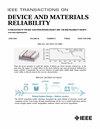Exponential Gain Degradation Behavior on Irradiated InP/InGaAs Double Heterojunction Bipolar Transistors
IF 2.3
3区 工程技术
Q2 ENGINEERING, ELECTRICAL & ELECTRONIC
IEEE Transactions on Device and Materials Reliability
Pub Date : 2025-07-17
DOI:10.1109/TDMR.2025.3590272
引用次数: 0
Abstract
In this paper, the effects of 2 MeV-proton irradiation on the electrical characteristics of InP/InGaAs double heterojunction bipolar transistors (DHBTs) are investigated. The device characteristics suddenly degraded for proton fluences exceeding辐照InP/InGaAs双异质结双极晶体管的指数增益衰减行为
本文研究了2mev质子辐照对InP/InGaAs双异质结双极晶体管(dhbt)电特性的影响。当质子影响超过$1\乘以10{^{{13}}}$ cm−2时,器件特性突然退化,当质子影响达到$1\乘以10{^{{13}}}$ cm ${}^{-}2 $时,器件几乎失效。基极电流的增加直接导致电流增益的降低。结果表明,辐照的InP/InGaAs dhbt的互反增益与质子能量的关系在5\乘以10{^{{13}}}$ cm ${}^{-}2 $以下的较宽能量范围内呈指数关系,而不是像messinger - spratt方程所描述的线性关系。基极电流分量和微拉曼光谱分析表明,辐照缺陷作为带电中心在BE结上的静电电位调制效应是导致增益下降的主要原因。此外,与其他双极晶体管的辐照效应的比较增强了我们对辐射诱导缺陷对不同晶体管结构的增益退化的不同影响的理解。
本文章由计算机程序翻译,如有差异,请以英文原文为准。
求助全文
约1分钟内获得全文
求助全文
来源期刊

IEEE Transactions on Device and Materials Reliability
工程技术-工程:电子与电气
CiteScore
4.80
自引率
5.00%
发文量
71
审稿时长
6-12 weeks
期刊介绍:
The scope of the publication includes, but is not limited to Reliability of: Devices, Materials, Processes, Interfaces, Integrated Microsystems (including MEMS & Sensors), Transistors, Technology (CMOS, BiCMOS, etc.), Integrated Circuits (IC, SSI, MSI, LSI, ULSI, ELSI, etc.), Thin Film Transistor Applications. The measurement and understanding of the reliability of such entities at each phase, from the concept stage through research and development and into manufacturing scale-up, provides the overall database on the reliability of the devices, materials, processes, package and other necessities for the successful introduction of a product to market. This reliability database is the foundation for a quality product, which meets customer expectation. A product so developed has high reliability. High quality will be achieved because product weaknesses will have been found (root cause analysis) and designed out of the final product. This process of ever increasing reliability and quality will result in a superior product. In the end, reliability and quality are not one thing; but in a sense everything, which can be or has to be done to guarantee that the product successfully performs in the field under customer conditions. Our goal is to capture these advances. An additional objective is to focus cross fertilized communication in the state of the art of reliability of electronic materials and devices and provide fundamental understanding of basic phenomena that affect reliability. In addition, the publication is a forum for interdisciplinary studies on reliability. An overall goal is to provide leading edge/state of the art information, which is critically relevant to the creation of reliable products.
 求助内容:
求助内容: 应助结果提醒方式:
应助结果提醒方式:


